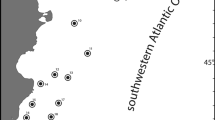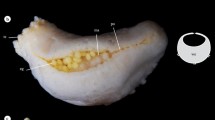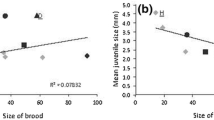Abstract
The sexually produced young of the externally brooding actinian Epiactis prolifera Verrill, 1869 are attached to the parent's column just above the base. A transitory “brood groove” may be formed around the limbus when the parent contracts. In the population studied on the coast of Sonoma County, California, USA, from 27 to 49% of the adult anemones were brooding at any time, the proportion being inversely related to seawater temperature and directly related to size of the anemones. A brood usually consisted of young of various sizes. Overall, number of young being brooded was directly related to parent size and inversely related to size of the brooded juveniles. The growth rate of juvenile anemones was inferred to average about a millimeter in pedal disc diameter per month. Juveniles dislodged from the parent when smaller than 4 mm in basal diameter apparently cannot survive in the intertidal zone. Juveniles which successfully make the transition to adulthood have, therefore, been brooded for at least 3 months. Fewer than 50% of the smallest juveniles survived to a size at which they could live independently. The transition to adulthood was accompanied by a mortality of 80%. The survival rate, from egg to adult, was calculated to be about 1% per season.
Similar content being viewed by others
Literature Cited
Braun, E. and V. Brown: Exploring Pacific coast tide pools, 56 pp. Healdsburg, California: Naturegraph Co. 1966
Buchsbaum, R. and L.J. Milne: The lower animals: living invertebrates of the world, 303 pp. Garden City, N.Y.: Doubleday & Co. Inc. 1960
Carlgren, O.: Actiniaria. Dan. Ingolf-Exped. 5 (9, part I), 1–241 (1921)
—: A survey of the Ptychodactiaria, Corallimopharia and Actiniaria. K. svenska Vetensk-Akad. Handl. (4th ser.) 1, 1–121 (1949)
Chia, F.S. and M.A. Rostron: Some aspects of the reproductive biology of Actinia equina (Cnidaria: Anthozoa). J. mar. biol. Ass. U.K. 50, 253–264 (1970)
— and J.G. Spaulding: Development and juvenile growth of the sea anemone, Tealia crassicornis. Biol. Bull. mar. biol. Lab., Woods Hole 142, 206–218 (1972)
Dunn, D.F.: Natural history of the sea anemone Epiactis prolifera Verrill, 1869, with special reference to its reproductive biology, Ph.D. thesis, University of California, Berkeley, California 1972
—: Gynodioecy in an animal. Nature, Lond. 253, 528–529 (1975a)
—: Reproduction of the externally brooding sea anemone Epiactis prolifera Verrill, 1869. Biol. Bull. mar. biol. Lab., Woods Hole 148, 199–218 (1975b)
Hand, C.: Class Anthozoa. In: Light's manual: intertidal invertebrates of the central California coast, 3rd ed. pp 85–94. Ed. by R.I. Smith and J.T. Carlton, Berkeley, Los Angeles & London: University of California Press 1975
Hedgpeth, J.W.: Introduction to seashore life of the San Francisco Bay region and the coast of northern California, 136 pp. Berkeley & Los Angeles: University of California Press 1962
Hewatt, W.G.: Ecological studies on selected marine intertidal communities of Monterey Bay, California. Am. Midl. Nat. 18, 161–206 (1937)
MacGinitie, G.E. and N. MacGinitie: Natural history of marine animals, 2nd ed. 523 pp. New York: McGraw-Hill Book Co. 1968
Ottaway, J.R. and I.M. Thomas: Movement and zonation of the intertidal anemone Actinia tenebrosa Farqu. (Cnidaria: Anthozoa) under experimental conditions. Aust. J. mar. Freshwat. Res. 22, 63–78 (1971)
Ricketts, E.F. and J. Calvin: Between Pacific tides, 4th ed., revised by J.W. Hedgpeth. 614 pp. Stanford, California: Stanford University Press 1968
Siebert, A.E., Jr.: A description of the sea anemone Stomphia didemon sp. nov. and its development. Pacif. Sci. 27, 363–376 (1973)
Stephenson, T.A.: The British sea anemones, Vol. 1. 148 pp. London: Ray Society 1928
Verrill, A.E.: Synopsis of the polyps and corals of the North Pacific Exploring Expedition. Part IV. Actinaria. Communs Essex Inst., Salem 5, 315–330 (1868)
— Notes on Radiata in the museum of Yale College, with descriptions of new genera and species. Trans. Conn. Acad. Arts Sci. 1, 247–596 (1869)
—: Descriptions of imperfectly known and new actinians, with critical notes on other species, V. Am. J. Sci. 157, 375–380 (1899)
Wilson, E.B.: The development of Renilla. Phil. Trans. R. Soc. 174, 723–815 (1884)
Author information
Authors and Affiliations
Additional information
Communicated by J.S. Pearse, Santa Cruz
This work was done in partial fulfillment of the requirements for the Ph.D. degree in the Department of Zoology, University of California, Berkeley, and was supported by a U.S. National Science Foundation Traineeship.
Rights and permissions
About this article
Cite this article
Dunn, D.F. Dynamics of external brooding in the sea anemone Epictis Epiactis prolifera . Mar. Biol. 39, 41–49 (1977). https://doi.org/10.1007/BF00395591
Accepted:
Published:
Issue Date:
DOI: https://doi.org/10.1007/BF00395591




